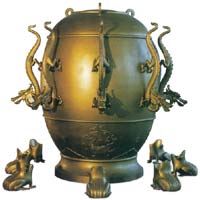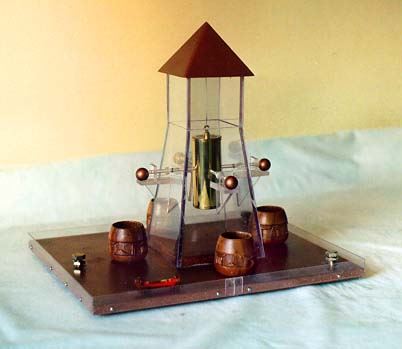|
- Home
- Ancient Seismometer
Ancient Seismometer
A seismometer — an earthquake detector — was invented in 132 A.D., by Chang Heng, a brilliant mathematician and scientist in the Han Dynasty.
The ancient Chinese believed seismic events, with their death and destruction, were important signs from heaven. So it was important to the Han Court to be alerted to earthquakes occurring anywhere in the kingdom. A correct call wins one immortal fame, as in Chang Heng’s case, while disgrace and punishment awaits a wrong call.
What did the original seismometer look like?

Chang Heng’s original seismometer was lost. Luckily, its description survived. It was a cast bronze vessel with a domed lid, resembling a wine jar. The working innards, of “toothed machinery and ingenious constructions,” were hidden. The surface of the vessel was decorated with motifs of mountains, tortoises, birds, animals and antique writing. Around the vessel were eight dragons whose mouths held a ball. Around the base of the vessel sat eight corresponding toads with their mouths open, looking upwards.
The sign for an earthquake was the falling of a ball from the dragon into the mouth of a toad. The direction of the earthquake is indicated by the position of the toad which swallowed the ball. This instrument was most remarkable:
On one occasion one of the dragons let fall a ball from its mouth though no perceptible shock could be felt. All the scholars at the capital were astonished at this strange effect occurring without any evidence of an earthquake to cause it. But several days later a messenger arrived bringing news of an earthquake in Lung-Hsi (400 miles away). Upon this everyone admitted the mysterious power of the instrument.
The workings of Chang Heng’s seismometer were never revealed. Most experts agree however, that it worked on the principle of inertia. A mass is suspended. An earthquake shakes the vessel, causing a slight displacement between the unmovable mass and the vessel. This movement is transmitted via levers to push out a ball. In the design of any instrument, the goal is to make the instrument sensitive to the desired signal while simultaneously rejecting false signals. For a pendulum, this optimal point is at its resonance.
Our seismometer is intended as a demonstrator. The visitor shakes the table to simulate an earthquake. Our pendulum is “tuned” to this input. The crust of the earth absorbs the high frequency content of a quake, the signal from a distant earthquake is in the sub-audio range. In order to detect actual earthquakes the pendulum would need to be several feet in length.
Indeed, we read that Chang Heng’s seismometer was described as having a diameter of “eight chhih”! (A little more than 6 ft.) His device appears to be incredibly “scientifically designed.” In 132 A.D., did he “really know” what we know today? Or did he hit on it by pure luck? Earthquakes occur so infrequently, how does one study it? Consider also the expense of making bronze castings the size of a horse in that age.
Another question you may want to ponder is why did Chang Heng take such pains to decorate his instrument with celestial motifs. What was the real purpose of these decorations? Do you think this helps the instrument to function better? Or did he hope this would make his device more believable?

Notes on the design and construction of the model seismometer:
- The pendulum is loaded with metal washers, weighing 600 grams. Its mass should be much greater than the mass of the moving parts, the rods and balls, combined.
- The length of the pendulum is 23 cm.
- The resonant frequency of a pendulum varies inversely with the square-root of its length: ? = 1/2p v(g/l) , where: ? is the resonant frequency in Hertz or cycles per second, g is the gravitational constant, 9.8 m/sec2 , and l the length of the pendulum in meters.
- The resonant frequency of our pendulum is 1.04 Hz.
- The balls are of low mass wood, available at hobby shops (selected with calipers for roundness and identical size.) The balls are positioned in shallow indentations on the platforms.
- The arms are low mass hollow Plexiglas tubes, free to move longitudinally, each trimmed to just touch the pendulum and the ball.
- The model should be perfectly level; note the adjustable legs and the red bubble levels (one hidden.)
- Not shown are various weights of bricks and rocks placed on the table so that its resonance matches that of the model seismometer.
- The frequency content of distant earthquake is in the range of 0.01 Hz, to detect it the pendulum has to be 10 times longer, or over seven feet long.
Further Information:
The following are available at the San Jose Library:- Science and Civilization in China, by Joseph Needham and others, several volumes.
- The Shorter Science & Civilization in China, edited by Colin A. Ronan, two volumes.
- The Genius of China, by Robert Temple.
- Everyday Life in Early Imperial China, by Michael Loewe.
- USGS webpage, The Early History of Seismometry (to 1900)
Acknowledgment:
The materials for this model were donated by and the model fabricated in the workshop of The Tech Museum of Innovation, San Jose.
Submitted by Stanley Hoo: Based on his exhibit at the 1999 Chinese Summer Festival. (Revised Sept. 2010)

